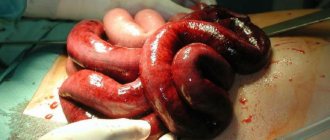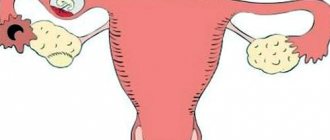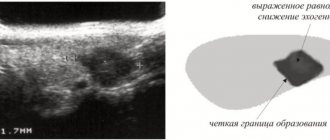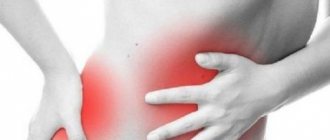Do not self-medicate. At the first signs of illness, consult a doctor.
- Etiology
- Symptoms
- Diagnostics
- Treatment
- Prevention and prognosis
A burning sensation in the abdomen is a fairly common clinical sign, which in the vast majority of cases has a pathological basis. Often this symptom is expressed due to the development of pathologies in the digestive system; less often it occurs with ailments of other internal organs and systems. The predisposing factor may differ depending on the location of the burning sensation.
A burning sensation in the abdomen or stomach will never form the basis of the clinical picture. Most often, the main symptom is accompanied by nausea and vomiting, disruption of the bowel movement and fever.
To establish the source of such an unpleasant symptom, it is necessary to seek help from a gastroenterologist, who will prescribe a wide range of laboratory and instrumental diagnostic measures, and, if necessary, refer the patient for consultations with other clinicians.
To eliminate such an unpleasant sensation, it is necessary to cure the underlying disease, and to eliminate only the symptom, conservative therapeutic treatment methods are sufficient.
Burning in the abdomen: Case reports
Male, 47 years old, worker.
From the anamnesis it is known that the first symptoms of the present disease appeared in him 17 years ago, a year after the patient was in a car accident (concussion of the 2nd degree of severity). Abdominal pain began after eating.
The local physician referred for gastroscopy (conclusion: superficial catarrhal gastritis). Drug therapy was prescribed (coatings, enzymes, diet). However, no improvements were observed within six months. Repeated gastroscopy showed normal gastric mucosa. The diagnosis of gastritis was removed, another one was made - intestinal dysbiosis, and probiotics were prescribed.
Over the following years, the condition gradually worsened, with heartburn, frequent (up to eight times a day) bowel movements, a burning sensation in the abdomen after eating, which were replaced by severe pain, flatulence (“the stomach inflates like a drum”).
A man contacted the Clinical Center for Autonomic Neurology in January 2010 with complaints of a burning sensation in the abdomen, severe flatulence, indigestion, insomnia, anxiety, and severe weight loss (due to intolerance to many foods, he followed a strict diet, eating once a day).
All symptoms of the disease disappeared two months after the first course of therapy. A repeat course was carried out at the patient’s request to “consolidate the positive results.” To this day he feels completely healthy.
Woman, 30 years old, housewife.
She turned to us for help two years after the onset of the disease, in 2008.
Complaints of a burning sensation in the lower part of the sternum and epigastric region, “as if it were hot there.” These sensations appeared to her sporadically (several times a day) and lasted from 10 to 30 minutes.
Constant general weakness, chills, nausea, trembling in the body. In order to get rid of the unpleasant sensations, she needed to lie down for at least 15 minutes. After rest, the discomfort went away.
These symptoms indicated “interest in the solar plexus nodes,” which was confirmed by a computer thermal imaging study.
The woman underwent a set of physiotherapeutic procedures aimed at normalizing the functioning of the solar plexus. To date, she has no health complaints.
Male, 30 years old, driver.
At the time of contacting the autonomic neurology center, the patient was not working due to existing complaints. The main complaint was frequent urge to defecate, sudden and very painful intestinal spasms. Loose stools were observed at least ten to fifteen times a day...
A driver by profession, the patient was forced to change jobs frequently because he could not perform his duties. “Every half hour I ran and looked for any gateway.” For the same reason, I couldn’t stand long trips on public transport.
Despite the strictest diet and even weeks of fasting, the symptoms did not go away. And any meal caused severe stomach turmoil and colic.
At the Clinical Center for Autonomic Neurology, the patient underwent two courses of therapy. Positive dynamics were noted already in the second week after the course. And six months later, all symptoms of gastrointestinal disorders disappeared completely.
Etiology
A burning sensation in the abdominal area can be caused by a wide variety of reasons, which are most often associated with disruption of the functioning of the gastrointestinal tract. In addition, external ailments can be sources:
- genitourinary system;
- skin;
- of cardio-vascular system;
- nervous system.
In addition, this manifestation is often expressed during pregnancy. Such a manifestation, depending on the etiological factor, can be localized both in the upper and lower parts of the anterior wall of the abdominal cavity.
A burning sensation in the lower abdomen in women and men can be caused by:
- Crohn's disease;
- cystitis and urethritis, pyelonephritis and prostatitis, as well as other pathologies of the genitourinary system;
- congestive processes, malignant or benign tumors in the pelvic area;
- herpes zoster;
- nonspecific ulcerative colitis;
- urolithiasis or the formation of stones in the ureters;
- esophagitis.
As for only female representatives, a burning sensation in the left or right side of the lower abdomen is caused by:
- ectopic pregnancy;
- the course of endometriosis;
- the formation of cysts in the left or right ovary;
- ruptures of ovarian follicles.
Endometriosis is a possible cause of burning in the lower abdomen
In cases of burning sensations in the abdomen during pregnancy, the sources may differ depending on the period of intrauterine development of the fetus it appeared. For example, in the first trimester, this may indicate an abnormal pregnancy, i.e. the development of a fertilized egg outside the uterus. In the second trimester, symptoms are usually explained by stretching of the abdominal muscles, but the possibility of miscarriage cannot be ruled out. In the last trimester, such a manifestation indicates the beginning of labor.
A burning sensation in the right side of the abdomen is caused by:
- inflammation of the cecum;
- irritable bowel syndrome;
- psychogenic disorders.
The causes of burning in the upper abdomen in representatives of both sexes and in children are:
- cholecystitis and pancreatitis - such diseases provoke burning and discomfort in the area above the navel;
- ulcerative lesions of the duodenum or stomach - in this case, the main symptom will appear after eating food;
- the formation of a diaphragmatic hernia - in such situations, the burning sensation is localized in the area above the navel;
- the occurrence of inflammation in the intestines;
- inflammation of the abdominal muscles, which is also called myositis;
- development of metabolic disorders;
- pathologies of the spleen;
- pleurisy and acute myocardial infarction;
- inflammation of the lower part of the lungs;
- aortic aneurysm and ischemic disease;
- intercostal neuralgia;
- the period of bearing a child - during late pregnancy, a similar sensation often occurs in the upper abdomen, less often in the lower;
- pathological influence of the bacterium Helicobacter pylori.
In addition, a burning sensation in the abdomen, both below and above, is caused by:
- uncontrolled use of medications, in particular antibacterial substances, analgesics, anti-inflammatory non-steroidal drugs and hormonal drugs;
- prolonged exposure to stressful situations;
- poor nutrition, namely consumption of excessively cold or extremely hot foods;
- helminthic infestation;
- long-term addiction to bad habits.
It is advisable to apply all of the above etiological factors to both adults and children, with the exception of a burning sensation in the lower abdomen during pregnancy.
VSD in faces
This page contains excerpts from patient histories, covering the main complaints with which people turn to us for help. This is done with the goal of showing how different and “complex” the symptoms of vegetative-vascular dystonia can be. And how closely it is sometimes “fused” with disturbances in the functioning of organs and systems. How it “disguises” itself as “heart”, “pulmonary”, “stomach”, “gynecological” and even “psychiatric” problems that people have to live with for years...
To learn more
Treatment
The burning sensation in the abdomen can be completely eliminated only after the pathological etiological factor has been eliminated.
Symptomatic treatment, aimed only at stopping this manifestation, may include the following conservative techniques:
- taking medications, in particular, enzyme substances, antacids, enveloping and antimicrobial agents;
- physiotherapeutic procedures;
- diet therapy - adherence to a gentle diet is indicated for all patients. The diet involves giving up fatty and spicy foods, pickles and marinades, smoked and canned foods, flour and sweets, chocolate and coffee, alcohol and soda. It is also very important to monitor the temperature of food;
- use of traditional medicine recipes, but only after the approval of the attending physician;
- course of therapeutic massage and exercise therapy.
As for surgical treatment, the issue of surgery is decided individually with each patient, especially if a burning sensation occurs in the lower abdomen during pregnancy.
Small intestinal obstruction and mesenteric blood flow disorders
Abdominal pain may be due to intestinal obstruction.
Small intestinal obstruction is a disruption in the movement of intestinal contents through the digestive tract.
Obstruction occurs due to pathology of motor function, which causes a large amount of gases and feces to accumulate in the intestines.
This leads to intoxication of the body, as well as to the development of anaerobic and aerobic parasites that are capable of producing hydrogen and methane.
This disorder leads to volvulus and is accompanied by painful sensations in the navel area. Symptoms of intestinal obstruction:
Burning mouth syndrome
Probably every gastroenterologist in his practice has encountered a patient with complaints of pain or burning of the tongue. Turning to this specialist in the first place is probably due to the following logical chain: the tongue is in the oral cavity, where the digestion process begins, which means that if a problem arises, you should visit a gastroenterologist. Old publications also come to the aid of patients and doctors of other specialties, in which chronic diseases of the digestive organs were considered as the causes of burning tongue.
But is it really that simple? Is pain and burning of the tongue a separate disease and who should treat it?
A little history and terminology.
Pain/burning in the tongue has many synonyms: glossalgia, glossodynia, stomatodynia, glossopyrosis, oral paresthesia, neurogenic glossitis, tongue neurosis, glossalgic syndrome. This condition is traditionally part of the so-called burning mouth syndrome or “burnt mouth syndrome,” in which pain/burning sensations are localized in various areas: tongue, upper palate, gums, lower lip, pharynx.
Burnt mouth syndrome (SMS) was first described back in 1880; in the 20th century, the term glossodynia, i.e., appeared. pain in the tongue, since unpleasant symptoms from the tongue were most common. This syndrome was first identified as a separate disease in 2004.
Almost all existing review articles and recommendations consider glossodynia within the framework of the SOP. General recommendations for the diagnosis and treatment of ROP may be applicable to the special case of glossodynia.
Definition
The International Association for the Study of Pain has designated glossodynia and oral burning as chronic pain, specifically “burning pain of the tongue or other mucous membranes of the mouth.”
Later, a detailed definition was given for ORS: “a burning sensation or sensation of altered sensitivity in the oral cavity, repeated daily for more than 2 hours a day for more than 3 months, without obvious causative lesions on clinical examination and examination.”
Epidemiology
Data on the prevalence of ROP and tongue pain/burning separately still vary from study to study. The average incidence of all cases of oral burning (including but not limited to tongue burning) is 0.1-3.7% of the population. Women suffer from this syndrome 2.5-7 times more often than men, especially often over the age of 60 and after menopause.
Common causes of pain and burning in the mouth.
There are two groups of reasons why patients notice a burning sensation in the mouth:
1) Primary (idiopathic), when there are no diseases of the oral cavity and other organs and systems, this will be the true SOR.
2) Secondary, caused by local (localized in the oral cavity) and systemic causes (autoimmune diseases, deficiency conditions, etc.)
Causes of secondary burning sensation in the mouth/burning tongue.
Possible causes of secondary burning sensation in the oral cavity are diverse and, oddly enough, are rarely associated with pathology of the digestive organs. A review published in 2022 on this problem identified the following conditions and diseases responsible for the occurrence of burning sensation in the mouth:
Local factors:
A. Diseases, conditions and damage to the oral cavity:
- fungal infection (eg candidiasis)
- lichen planus
- pemphigoid
- pemphigus
B. Trauma
1) Mechanical
2) Chemical
A. From the patient's side:
- toothpastes with abrasives
- use of mouth rinses with ethyl alcohol
- medications such as aspirin (applied to the sore tooth); over-the-counter medications containing phenols, peroxide, sulfuric acid
- vitamin C (citrus fruits)
- sour drinks
- lozenges and cough suppressants with high menthol content
b. From the dentist:
- Irrigation of the oral cavity with solutions containing methyl methacrylate, formaldehyde, formocresol, sodium hypochloride
- acrylic resin
- eugenol
3) Thermal: spicy or hot food or drink
C. Parafunctional habits
- Tongue sticking out, cheek biting, excessive tongue brushing
- mouth breathing
D. Xerostomia or impaired quality/quantity of saliva
- consequences of radiation or chemotherapy, Sjogren's syndrome, pathology of the salivary glands
- side effects of medications (antihistamines, antidepressants, diuretics, steroid hormones, non-steroidal anti-inflammatory drugs, amphetamines)
- smoking
E. Allergic reaction/contact hypersensitivity
- products, additives, flavors
- colorings and flavors from oral care products
- dental materials (nickel sulfate, cobalt, zinc)
System factors
A. Deficiency conditions: decreased levels of iron, zinc, folic acid, vitamins B1, B2, B6, B12
B. Endocrine pathology
- diabetes
- hypothyroidism
- hormonal disorders (changes in cortisol/sex hormone levels)
C. Autoimmune diseases
- Sjögren's syndrome
- lichenoid reactions
- systemic lupus erythematosus
D. Other diseases
- gastroesophageal reflux disease
- celiac disease
- multiple sclerosis
- Parkinson's disease
- Fabry disease
E. Medicines
- angiotensin-converting factor inhibitors
- antiretroviral therapy
F. Peripheral and central neuropathies
- diabetic polyneuropathy, neuropathy due to renal failure, neuropathy due to systemic connective tissue diseases, neuropathy due to HIV infection, postherpetic neuropathy, neuropathy due to chemotherapy
As can be seen from this huge list, most cases of burning of the tongue and in the oral cavity in general are caused by a dental problem/pathology, neurological, endocrine and autoimmune diseases. Gastroenterological causes (for example, gastroesophageal reflux disease) are rather the exception to the rule.
Primary burning sensation in the oral cavity (BOR) and its causes.
If there are no indications of secondary causes of burning in the oral cavity, most likely there is a true SOR. This is an independent disease, the cause of which is still unclear. In its development, the role of psychological factors and mental disorders, changes in the nerve endings and conductive nerve fibers of the oral cavity, as well as the central nervous system is assumed.
Clinical manifestations of ROP.
Symptoms that may bother patients with ROP are:
1) Pain and/or burning in the mouth of varying intensity. Some patients describe these sensations as tingling or irritation, as well as impaired sensitivity. The pain often occurs spontaneously, is often symmetrical and does not necessarily affect only one area. In the case of glossodynia, pain/burning is most often localized in the anterior 2/3 of the tongue, on its back, and lateral surfaces. The pain is minimal in the morning immediately after waking up, increasing in intensity throughout the day. Eating spicy, hot foods and drinks, as well as stress and fatigue increase the pain/burning sensation.
2) More than 70% of patients, in addition to pain/burning, note changes in taste, a decrease in its intensity, as well as the appearance of a foreign taste (bitter, metallic, or a combination of both). Most often, the sensation of sweet and salty tastes is reduced, and sour tastes are perceived more intensely.
3) Dry mouth (xerostomia) is noted by 46-67% of patients with SOP, while according to research data, an objective decrease in the amount of saliva is not observed in them.
4) Association with burning/pain from other mucous membranes has also been described in patients suffering from ROP. Most often this is a burning sensation in the rectum and genital tract. An alternative may be a feeling of dry mucous membranes (eyes, genital tract in women)
5) Night sleep disturbances are common (in 80% of cases) in people with SRS
6) Anxiety and depression are frequent companions of SOR and glossodynia separately. A meta-analysis of clinical studies showed that anxiety conditions increase the risk of developing RAS by 2.6 times, and depression by 3.2 times. Cancerophobia, social phobia, neuroticism, etc. are also often noted.
7) ODS is characterized by an association with other diseases that manifest as chronic pain: fibromyalgia, chronic back pain, chronic pelvic pain, irritable bowel syndrome, etc.
Treatment of SOR.
1) Patient information and support
Many patients with chronic oral burning and pain do not understand why their symptoms persist for so long. An important task of the doctor is to explain to patients with SRS the possible mechanisms of the formation of unpleasant sensations. Patients should be reassured that their symptoms are not imaginary or related to any form of cancer. This support will reduce anxiety, depression, fear and frustration, especially in individuals who have had previous unsuccessful treatment experiences.
2) Local therapy
Local use of clonazepam in the form of mouth rinses showed good results in reducing the severity of pain/burning in the mouth. There is encouraging evidence for the topical use of capsaicin (a chili pepper alkaloid) in low concentrations.
3) Systemic therapy
Tricyclic antidepressants, antidepressants from the group of serotonin and serotonin/norepinephrine reuptake inhibitors, clonazepam, and antiepileptic drugs (pregabalin and gabapentin) are actively used as drugs for the treatment of ORA. The use of alpha-thioctic acid showed little effectiveness.
4) Non-drug psychotherapy
Given the frequent association of ODS with anxiety disorders, phobias and depression, non-pharmacological psychotherapy is an integral part of the treatment of this problem. Cognitive behavioral therapy, individual and group psychotherapy should be considered as methods of choice.
5) Physiotherapy and alternative treatments
Low-level laser therapy and acupuncture have been studied as methods for reducing pain. These methods were effective in some people with cerebral obstruction, but are not widely used.
Conclusion.
Identifying the causes of pain/burning in the oral cavity is a challenge for doctors of different specialties, but their friendly work allows us to solve the problem and improve the quality of life of patients.
Prevention and prognosis
To avoid problems with the occurrence of the main symptom, you should follow the general rules of prevention, including:
- rejection of bad habits;
- good nutrition;
- taking medications strictly as prescribed by the doctor, in compliance with the daily norm and duration of use;
- avoiding stress and nervous tension;
- Regularly undergoing a full examination at a medical institution.
In itself, a burning sensation in the abdomen above the navel or any other location cannot harm a person’s health and life. However, some of the pathological etiological factors, if not treated, lead to the development of quite dangerous complications.










